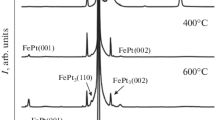Abstract
Possibilities of magnetic pseudoresonance (a non-resonance peak of magnetic susceptibility) were studied and compared with the ferromagnetic resonance (FMR) in measuring the parameters of thin ferromagnetic films with in-plane uniaxial magnetic anisotropy. The measurements were conducted with two characteristic samples of ferromagnetic films showing this effect. A Q-meter operating at a frequency near 300 MHz (for pseudoresonance) and a standard X-band magnetic resonance spectrometer (for FMR) were used. The Q-meter working at 300 MHz was shown to detect reliably the magnetic pseudoresonance in both epitaxial and polycrystalline films. It was found that the accuracy of determination of the magnetic anisotropy field and orientation of the easy magnetization axis provided by the pseudoresonance method is as good as with FMR, and in some cases the pseudoresonance method gives additional information.


Similar content being viewed by others
Notes
The sample was made at the International Laboratory LEMAC-LICS: IEMN, UMR CNRS 8520, PRES Lille Nord de France, France.
REFERENCES
B. A. Belyaev, A. V. Izotov, and S. Ya. Kiparisov, JETP Lett. 74, 226 (2001).
T. M. Vasilevskaya and D. I. Sementsov, J. Exp. Theor. Phys. 110, 754 (2010). https://doi.org/10.1134/S1063776110050043
V. A. Atsarkin, V. V. Demidov, A. E. Mefed, and V. Yu. Nagorkin, Appl. Magn. Reson. 45, 809 (2014). https://doi.org/10.1007/s00723-014-0554-2
A. E. Mefed and V. V. Demidov, Instrum. Exp. Tech. 51, 418 (2008). https://doi.org/10.1134/S0020441208030160
V. V. Demidov, I. V. Borisenko, A. A. Klimov, G. A. Ovsyannikov, A. M. Petrzhik, and S. A. Nikitov, J. Exp. Theor. Phys. 112, 825 (2011). https://doi.org/10.1134/S1063776111040029
I. V. Borisenko, V. V. Demidov, A. A. Klimov, G. A. Ovsyannikov, K. I. Konstantinyan, S. A. Nikitov, V. L. Preobrazhenskii, N. Tiercelin, and P. Pernod, Tech. Phys. Lett. 42, 113 (2016). https://doi.org/10.1134/S1063785016020048
A. G. Gurevich and G. A. Melkov, Magnetization Oscillations and Waves (Nauka, Moscow, 1994; CRC, New York, 1996), Chap. 2.1.
A. B. Drovosekov, O. V. Zhotikova, N. M. Kreines, V. F. Meshcheryakov, M. A. Milyaev, L. N. Romashev, V. V. Ustinov, and D. I. Kholin, J. Exp. Theor. Phys. 89, 986 (1999).
S. A. Al’tshuler and B. M. Kozyrev, Electron Paramagnetic Resonance (Fizmatlit, Moscow, 1961; Academic, 1964), Chap. 1.4.
Author information
Authors and Affiliations
Corresponding author
Additional information
Translated by S. Efimov
Rights and permissions
About this article
Cite this article
Demidov, V.V., Mefed, A.E. Capabilities of Magnetic Pseudoresonance in Studies of Thin Ferromagnetic Films with Uniaxial Magnetic Anisotropy. Tech. Phys. 64, 64–67 (2019). https://doi.org/10.1134/S1063784219010079
Received:
Published:
Issue Date:
DOI: https://doi.org/10.1134/S1063784219010079




